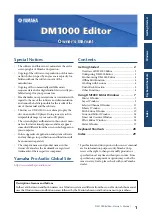
Creating and using structures
121
Deleting structure elements and structures
To delete a key and its value from a structure, use the
StructDelete
function, as follows:
StructDelete(
structure_name, key
[
, indicateNotExisting
])
The
indicateNotExisting
argument tells the function what to do if the specified key does not exist.
By default, the function always returns True. However, if you specify True for the
indicateNotExisting
argument, the function returns True if the key exists and False if it does not.
You can also use the
StructClear
function to delete all the data in a structure but keep the
structure instance itself, as follows:
StructClear(
structure_name
)
If you use
StructClear
to delete a structure that you have copied using the
StructCopy
function, the specified structure is deleted, but the copy is unaffected.
If you use
StructClear
to delete a structure that has a multiple references, the function deletes
the contents of the structure and all references point to the empty structure, as shown in the
following example:
<cfset myStruct.Key1="Macromedia">
Structure before StructClear<br>
<cfdump var="#myStruct#">
<cfset myCopy=myStruct>
<cfset StructClear(myCopy)>
After Clear:<br>
myStruct: <cfdump var="#myStruct#"><br>
myCopy: <cfdump var="#myCopy#">
Looping through structures
You can loop through a structure to output its contents, as shown in the following example:
<!--- Create a structure and set its contents --->
<cfset departments=structnew()>
<cfset val=StructInsert(departments, "John", "Sales")>
<cfset val=StructInsert(departments, "Tom", "Finance")>
<cfset val=StructInsert(departments, "Mike", "Education")>
<!--- Build a table to display the contents --->
<cfoutput>
<table cellpadding="2" cellspacing="2">
<tr>
<td><b>Employee</b></td>
<td><b>Department</b></td>
</tr>
<!--- Use cfloop to loop through the departments structure.
The item attribute specifies a name for the structure key. --->
<cfloop collection=#departments# item="person">
<tr>
<td>#person#</td>
<td>#Departments[person]#</td>
</tr>
</cfloop>
</table>
</cfoutput>
Summary of Contents for COLDFUSION MX 61-DEVELOPING COLDFUSION MX
Page 1: ...Developing ColdFusion MX Applications...
Page 22: ...22 Contents...
Page 38: ......
Page 52: ...52 Chapter 2 Elements of CFML...
Page 162: ......
Page 218: ...218 Chapter 10 Writing and Calling User Defined Functions...
Page 250: ...250 Chapter 11 Building and Using ColdFusion Components...
Page 264: ...264 Chapter 12 Building Custom CFXAPI Tags...
Page 266: ......
Page 314: ...314 Chapter 14 Handling Errors...
Page 344: ...344 Chapter 15 Using Persistent Data and Locking...
Page 349: ...About user security 349...
Page 357: ...Security scenarios 357...
Page 370: ...370 Chapter 16 Securing Applications...
Page 388: ...388 Chapter 17 Developing Globalized Applications...
Page 408: ...408 Chapter 18 Debugging and Troubleshooting Applications...
Page 410: ......
Page 426: ...426 Chapter 19 Introduction to Databases and SQL...
Page 476: ...476 Chapter 22 Using Query of Queries...
Page 534: ...534 Chapter 24 Building a Search Interface...
Page 556: ...556 Chapter 25 Using Verity Search Expressions...
Page 558: ......
Page 582: ...582 Chapter 26 Retrieving and Formatting Data...
Page 668: ......
Page 734: ...734 Chapter 32 Using Web Services...
Page 760: ...760 Chapter 33 Integrating J2EE and Java Elements in CFML Applications...
Page 786: ...786 Chapter 34 Integrating COM and CORBA Objects in CFML Applications...
Page 788: ......
















































